- info@wildlife-removal.com
Call us for help in your town
Wildlife Removal Education
Squirrel Trapping - How To Trap
Need squirrel removal in your hometown? We service over 500 USA locations! Click here to hire us in your town and check prices - updated for year 2020.
This guide teaches proper method, strategy, and technique for squirrel trapping. Note - this is live trapping, in steel cage traps. This guide does not cover lethal trapping means. Using
live traps is safer, easier, and if done right, more effective and efficient than lethal traps (you can catch many squirrels quickly with cage or repeater traps, for example). With cage
traps, the usual intent is to relocate squirrels out of the area in which they are causing a problem.
Please be aware that mere trapping won't necessarily solve your squirrel problem - new squirrels will quickly move in to replace the old ones. If there's squirrels in the attic, there
is probably a nest of baby squirrels up there. If squirrels are chewing, trapping won't stop new ones from doing the same. The situation is often more complex than simply setting out
a cage trap and removing the animals. And to be honest, trapping unto itself is an art, and it's not necessarily easy. As with everything, experience matters a great deal.
What type of trap should I use? Either a squirrel-size cage trap, or a repeater trap or a one-way exclusion door, if you just want to get the squirrels out of a building, and don't
want to actually trap and relocate them. These three types of traps are shown in the below photo:
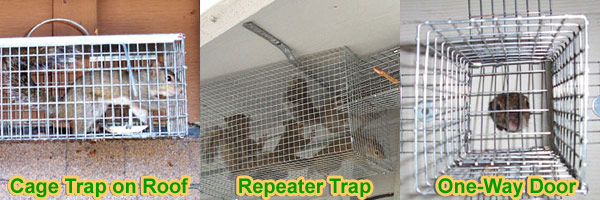
Cage Trap: You can set a cage trap in a variety of places, from on a roof, in a tree, or on the ground. You can even set one in
an attic, although it won't catch anything there. It's important to use the right size trap - too small, and the animal won't be able to enter, or the trap won't be able to close. Too large, and
it may not trip shut, and the squirrel will have a lot of room to run around and smack its face into the steel bars, which is actually a problem. I use traps 14-18" long and 6" high and wide.
Repeater Traps: Pictured below, are mounted directly on a building, right over a hole squirrels are using to enter and exit a house. The trap should have flanges, or wings on one end, to
mount the trap to the building, and a torsion-spring repeating one-way door leading into the cage. This type of setup is the best way to catch the target squirrels, and
not all the squirrels in the area. Although, squirrels do tend to be territorial, so cage traps set outside the house will not "catch every squirrel in the neighborhood" as some people worry.
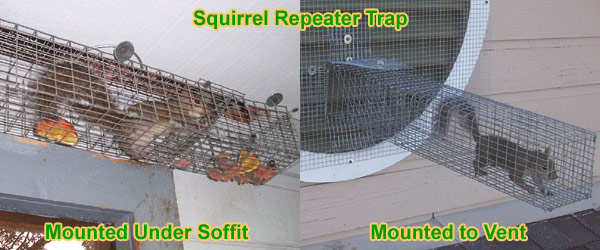
One-Way Door: A one-way exclusion door works like the repeater trap, except it's open on the end, instead of an enclosed cage. The one-way door is a great option for simply getting all of
the squirrels out of a house, and not letting them back in. Don't use this trap if there are areas that squirrels can use to chew their way back in - only use it on secure homes with well-defined
entry/exit holes. Read more about using a snare pole to catch a squirrel.
What kind of bait should I use? Cage traps should be baited with peanut butter and whole peanuts in the shell. Sure, you can use other nuts and seeds if you want. Repeater traps and one-way
doors do not require any bait. Read more on my squirrel bait page.
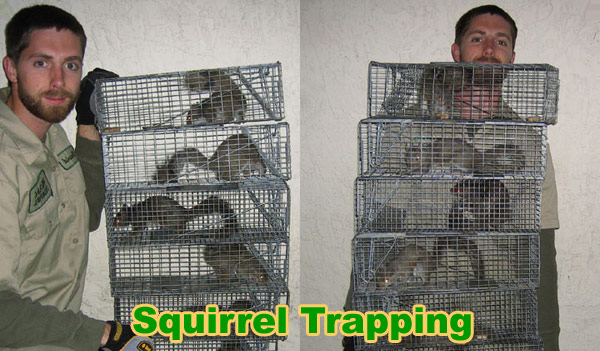
Be sure to set the trap on a secure surface. If it wobbles too much, the squirrel may not fully enter. The trip pan tension must be set right. Don't set the trap in the sun if you can help it -
squirrels can die very quickly from heat exhaustion. If you do trap, be sure to check the traps frequently, so that the animal is not suffering in a trap for too long. Squirrels tend to get very
hyper and antsy once trapped.
If you need to know how to trap squirrels in an attic, setting the traps in the attic itself will accomplish nothing. They won't enter traps inside the attic. Click here for my full guide on
how to get squirrels out of the attic.
How To Trap Squirrels Inside House Living Quarters -
As fast as a squirrel can be, it may seem like an impossible task to learn how to trap a squirrel. That would be true if you were trying to trap it with your bare hands; that would certainly not be the best way to do it. There are a few ways to trap a squirrel in most situations that will make it a lot easier on you. The safest and easiest way to trap a squirrel is using a trap, but traps are not always available. It is not like people keeps squirrel traps in their home. That would involve going to the store, getting one and setting it up, but what if you need to trap the squirrel right now?
If you want to know how to trap a squirrel inside a house, then all you really will need is a blanket. This method is used if the squirrel has just darted into your home and you are in a room where you can get the squirrel in a corner. First you will need to corner the squirrel, this may be a bit difficult if you do not have any help, but eventually you will do it. Bear in mind offering an
escape route is best. Though it is not recommended because of the high risk, all attempts at hand capture should involve thick gloves and a blanket. Drop the blanket on the squirrel as if you were fishing with a net. Wrap the squirrel in the blanket and release it outside quickly. If you just
need general info about getting rid of squirrels, read my How to Get Rid of Squirrels page, full of advice and tips in lots of squirrel problem situations.
Out of all squirrel species, the Eastern Gray tree squirrel constitutes a great nuisance to homeowners because of their fondness for attic living. They typically make a lot of noise and leave a messy damage anywhere they inhabit. The naturally abundant population of squirrels, coupled with deforestation and decreasing habitats translates to more and more of these squirrels seeking shelter in homes, especially in the cold months of winter.
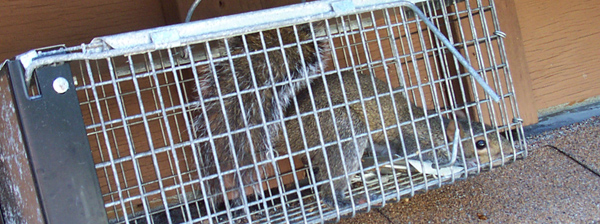
The purpose of trapping squirrels is to relocate them far away from your property. Trapping is a very good technique for getting rid of squirrel pests, but will not wholly solve the problem. If precautions are not taken to exclude new squirrels, they would quickly replace the removed ones.
Remember, trapping is only one part of the process. You might also want to read my Squirrel Prevention Tips and What to Do With Trapped Squirrels.
Squirrel Trap Types
There are several types of traps available, but live traps are ideal for a humane removal. Traditional cage traps have one door and can be used almost anywhere squirrels have been sighted; they are effective enough when set up correctly. Squirrel traps are typically small, but must be large enough to take the animal’s whole body before it gets to the trigger. Different trap types include:
- Repeater traps
- One-door traps
- Two-door traps
- One-way exclusion traps
Baits and Lures
Although squirrels eat a wide variety of food, the foods that attract them the most are nuts, seeds, grains, herbs, fruits, and soft vegetables. For instance, you may use bird seed as bait if the squirrel has been stealing from your bird feeder. Things to consider while baiting your trap:
- The purpose of a bait is not only to lure a squirrel into the trap, but also to convince it to activate the trigger mechanism inside. Thus, the bait must be positioned just right.
- The bait’s position inside the trap must be deep enough to coax the squirrel to enter fully – body and tail.
- It should be able to lure the squirrel to put its weight on the trigger plate. One way is to smear peanut butter or molasses directly on the trigger plate and then stick a nut on it.
- Bait should not be reachable from outside the trap. Nuts, for instance, should not be smaller than the cage mesh.
- Wear gloves when baiting a trap so you don’t leave your scent on it. Squirrels can usually perceive human scents and may not be fooled.
Setting the Trap
The trap should be placed on a flat surface along the squirrel’s observed path. This could be at the base of a tree, in an attic, or along a wall close to the bird feeder. It is important that the trap does not wobble as this can discourage squirrels; you may even place a heavy object on it. Once you have set it, check the trap frequently for early detection of a catch so the animal does not suffer for long.
Relocation
After you have successfully trapped the squirrel pest(s) in your home, you can transport them several miles away from your neighborhood and release them, preferably in a wooded area. Always wear thick gloves while handling squirrels as they can bite when agitated.
Note that if the squirrel was in your attic, there is a high likelihood that it is a mother with her young still stashed away inside the attic. Female squirrels are known to seek warm enclosures to raise their kits. In this case, you must get the babies out as well to prevent them from starving to death. One way to identify a mother squirrel is to check its nipples.
After removing the squirrel(s), it is important that you carry out repairs and animal-proof your property or more squirrels will come in to replace their evicted members.
Lethal Traps
This kind of trap is both inhumane and unnecessary. They are also known as Body Grip Traps and are even dangerous to set; almost only used by old time fur trappers. The most common is the double spring-loaded connibear trap. They work by snapping down on the animal when sprung, and killing it via choking or squeezing. Lethal traps are inhumane and are not recommended for wildlife trappers. Live traps are the best kind to use.
Note: Ensure to avail yourself of the local wildlife regulations in your area before you attempt to trap and relocate a squirrel.
Squirrel Trapping Equipment
The kind of equipment and tools that you use to trap a squirrel will determine the outcome — whether it will be a bad one or a good one. A bad outcome is for the animal to come to some sort of harm during the trapping activity, and this can often happen when the wrong traps or other equipment types are used. A good outcome is where you have managed to trap or remove the animal, and any potential babies that it may have in a nest, as well as sealing up the property so that it can't come back in again. In fact, that should be the only outcome you’re looking for.
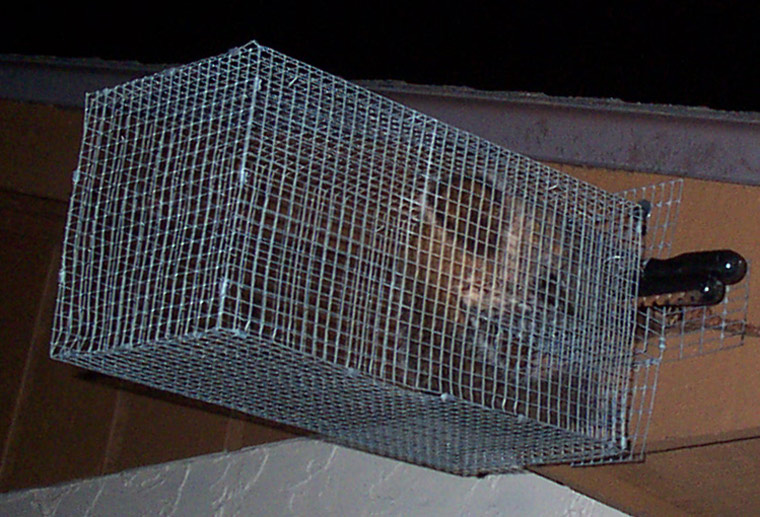
There are a number of different trap types for squirrels, although, they will usually fall under one of two categories — live traps or kill traps.
Live Squirrel Traps
Live squirrel traps will generally set you back somewhere in the region of $30 to $100, depending on the brand, model, and size of trap you buy. The more advanced it is, the more it will cost you. The old-fashioned wire cage traps are pretty effective for most wild animals, but you will want to make sure you have purchased a really good quality one to prevent any fatal accidents.
A lot of these live cage traps for squirrels have different features, but they all work in the same kind of way — the animal walks into the trap, attracted by bait food at the back, and then a trigger is set off to shut the door behind it. Once in the trap, it can’t get back out again.
The problem with live catching squirrels is that you won’t always know if you cave captured ALL of them. If the one you have in your trap is a mother and her young are hiding in a nest somewhere, you will only have solved a fraction of the problem.
Kill Traps for Squirrels
Kill traps are controversial for some, with pocket gopher traps, spring-loaded jaw traps, and even wire traps used as kill traps for squirrels. As with all trapping methods, but especially with kill traps, you will want to do a certain amount of research beforehand. Squirrels, in some places, are known as fur bearing animals and, therefore, come under the same restrictions, including open hunting seasons, that other fur bearing animals do.
Exclusion Traps for Squirrels
Exclusion traps work very much the same as live cage traps for squirrels, but instead of keeping the animal enclosed in the wire trap, the animal is quite literally free to walk right out the other end. The door will shut, just as with a live cage trap, but you're not trapping the animal in; just out of your home.
Exclusion traps let the animal find its own way to a new home, without you needing to worry about driving a great distance from your home to relocate it. The only problem with exclusion traps is that smaller squirrels can’t use it if they are not yet old enough or ready to leave the nest. If you use exclusion traps with mother and baby squirrels, you do run the risk that you will lock the young squirrels in, killing them after a while, and the mother out. As a result, she will either do whatever she needs to do to break back in and get to her babies, or she’ll be very sad, perhaps even depressed or stressed, leaving her in a vulnerable position.
The outcome is death.
Exclusion traps do work, on the other hand, for solo adult squirrels. In fact, exclusion traps can work quite effectively, as long as the rest of the building has been sealed. We recommend doing some investigative work before you lay any traps down, regardless of type, to see which holes and spaces seem to most the most visited. These are the areas that you will want to pay attention to when it comes to excluding or trapping them. There’s very little point in putting traps down where squirrels won't naturally find them.
Safety Equipment
Alongside the trap itself, you will need a large list of safety equipment to make sure that you keep yourself safe. Everything will need to be disposed of in an appropriate manner if you want to reduce the threat of diseases spreading, and everything will need to be thoroughly cleaned. If the squirrel has gotten in your attic, you may even find that electrical cables need to be repaired, as well as huge sections of the attic insulation replaced. Wild critters love to use the stuff to build their nests, and that, combined with dark and quiet, left-alone conditions, means that your attic provides the perfect home for a number of wild animals. The humble squirrel is just one of them.
Squirrel Trapping: Where to Release a Squirrel
In order to understand how far away you'd need to drive with a squirrel in a trap, you'll need to have a better understanding of what kind of habitat the animal likes to call home. After all, you want this creature to have the best start at life, don't you? If you've gone to the trouble of humanely trapping that animal to then release it back into the wild, we would assume that you don't want the outcome to be death.
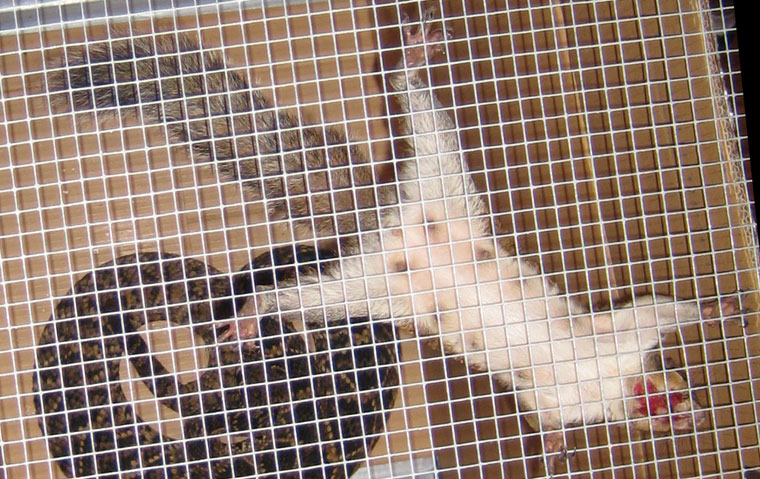
Sadly, many wild animal relocation jobs do result in death. Either that or the animal just comes right back, in some cases, quicker than you even get back there! Read more about keeping squirrels as pets.
Eastern gray squirrels -- the kind of squirrel you are likely to see in your back yard — can live in forests that cover an area of 100 hectares or more. That's not to say the entire area will be that animal's habitat, but that's just where they like to live. Plenty of trees mean they have a great way to get around, without becoming prey on the floor, and the trees also give the animals hiding spots, in the form of hollows and branch connections, as well as food. If that area has lots of undergrowth, even better. It means that the squirrel will be even safer.
Although squirrels won't live in that entire 100 hectare area, it is smart to assume that these animals can cover quite the surface area in virtually no time at all. Scampering and jumping from tree to tree, you're not going to want to release the animal into the woods or a forest that is close to your home. If you release the animal on one side of that treed area and you live on the other, it will only be a matter of time before it makes its way back again. Your problem will be back then too.
Squirrels can cover quite a large space when they live out in the wild, and this means that you will need to drive quite some distance to ensure you can keep the animal away. We personally recommend at least ten to fifteen miles away, and in a treed area that is nowhere near or connected to your property. If you can manage even further than that, you’ll have much better luck.
Go back to the Squirrel Removal page, or learn tips to do it yourself with the guides How to Get Rid of Squirrels, I Have a Cage-Shy Squirrel, What Should I Do? and Squirrel Trapping & Legalities: What You Need to Know.


















